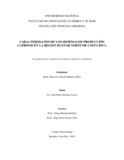| dc.contributor.author | Barboza Mora, Mauricio Alberto | |
| dc.date.accessioned | 2019-01-29T17:44:49Z | |
| dc.date.available | 2019-01-29T17:44:49Z | |
| dc.date.issued | 2018 | |
| dc.identifier.citation | Barboza Mora, M. (2018). Caracterización de los sistemas de producción caprinos en la Región Huétar Norte de Costa Rica. (Tesis de licenciatura). Universidad Nacional, Heredia. | es_ES |
| dc.identifier.other | 9926 | |
| dc.identifier.uri | http://hdl.handle.net/11056/14818 | |
| dc.description | Tesis para optar por el grado de Licenciatura en Ingeniería en Agronomía. | es_ES |
| dc.description.abstract | El estudio se realizó en los meses de febrero y junio del 2016, en la región Huetar Norte de
Costa Rica. El objetivo fue conocer la situación actual de los sistemas de producción caprina
de la región, desde la dimensión productiva, social y económica. Se utilizó la base de datos
del VI CENAGRO 2014, de todos los productores que poseen caprinos en la región, y una
herramienta (encuesta), la cual, se aplicó mediante visitas a todos los asociados activos de
Coopecaprina R.L. En total se utilizaron 15 variables (11 cualitativas y 4 cuantitativas). Se
determinó mediante estadística descriptiva (por medio del software estadístico PSPPIRE
(PSPP+GUI)), la distribución absoluta y porcentual para variables cualitativas, y los
resultados de tendencia central y dispersión, para variables cuantitativas, lo anterior,
utilizando los datos de la región y los de los asociados a Coopecaprina R.L. Además, se
realizó un análisis multivariante con las variables productivas de la región, por medio del
software R-COMMANDER, el cual conformó dos conglomerados de productores (sistemas
extensivos no especializados y sistemas intensivos especializados). También, se realizó una
comparación de los sistemas de producción a nivel local, regional y nacional. Los sistemas
de producción asociados a Coopecaprina R.L., poseen más de 21 animales, sistemas
estabulados, y destinan su producción al mercado local y la venta en finca. Estos sistemas
son liderados por hombres de 50.19±15.28 que poseen primaria y trabajan internamente en
la finca; mientras que, en estas fincas no se contrata mano de obra, ni se recibe
financiamiento. En la región, el 94% de los sistemas de producción posee menos de 20
animales, con sistemas de pastoreo, basados en pasturas naturales, y destinando la producción
a la venta en finca. Los sistemas son dirigidos por hombres de 54.34±13 años que poseen
primaria, no se asocian en organizaciones y laboran sin pago en sus fincas. La actividad
principal de las fincas corresponde a la actividad bovina, y no se contrata mano de obra, ni
se recibe financiamiento. Se conformaron dos conglomerados, el primero contiene 441
productores y el segundo 28. En cuanto a la comparación, las fincas de Coopecaprina R.L.
son de mayor tamaño, poseen en promedio mayor cantidad de animales, y porcentualmente,
estas reciben más financiamiento; mientras que, los productores poseen niveles académicos
más altos y destinan su producción a diferentes mercados, lo anterior, comparado con la
región y a nivel nacional. | es_ES |
| dc.description.abstract | The study was conducted in the months of February and June 2016, in the Huetar Norte
region of Costa Rica. The objective was to know the current situation of the goat production
systems of the region, from the productive, social and economic dimension. The VI
CENAGRO 2014 database was used, of all the producers that own goats in the region, and a
tool (survey), which was applied through visits to all the active associates of Coopecaprina
R.L. In total, 15 variables were used (11 qualitative and 4 quantitative). Descriptive statistics
were determined (using the statistical software PSPPIRE (PSPP+GUI)), the absolute and
percentage distribution for qualitative variables, and the results of central tendency and
dispersion, for quantitative variables, using data from the region and data from the associated
with Coopecaprina R.L. In addition, a multivariate analysis was carried out with the
productive variables of the region, through the R-COMMANDER software, which formed
two producer conglomerates (extensive non-specialized systems and specialized intensive
systems). Also, a comparison of the production systems at local, regional and national level
was made. The production systems associated with Coopecaprina R.L., have more than 21
animals, stable systems, and allocate their production to the local market and sale on the farm.
These systems are led by men of 50.19 ± 15.28 who own primary and work internally on the
farm; while, in these farms, labor is not hired, nor is financing received. In the region, 94%
of the production systems have less than 20 animals, with grazing systems, based on natural
pastures, and allocating the production to sale on the farm. The systems are directed by men
of 54.34 ± 13 years who have primary school, do not associate in organizations and work
without payment in their farms. The main activity of the farms corresponds to the bovine
activity, and labor is not hired, nor is financing received. Two conglomerates were formed,
the first contains 441 producers and the second 28. As for the comparison, the farms of
Coopecaprina R.L. they are larger, have on average more animals, and, in percentage, receive
more funding; while, the producers have higher academic levels and allocate their production
to different markets, the former, compared with the region and nationally. | |
| dc.language.iso | es | es_ES |
| dc.publisher | Universidad Nacional (Costa Rica). Escuela de Ciencias Agrarias. Licenciatura en Ingeniería Agronómica. | es_ES |
| dc.rights | Attribution-NonCommercial-NoDerivs 3.0 United States | * |
| dc.rights.uri | http://creativecommons.org/licenses/by-nc-nd/3.0/us/ | * |
| dc.subject | CAPRINOS | es_ES |
| dc.subject | PRODUCCIÓN DE ANIMALES | es_ES |
| dc.subject | GANADERÍA | es_ES |
| dc.subject | RUMIANTES | es_ES |
| dc.title | Caracterización de los sistemas de producción caprinos en la Región Huétar Norte de Costa Rica | es_ES |
| dc.type | http://purl.org/coar/resource_type/c_7a1f | es_ES |


